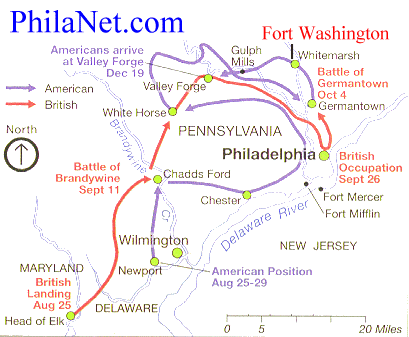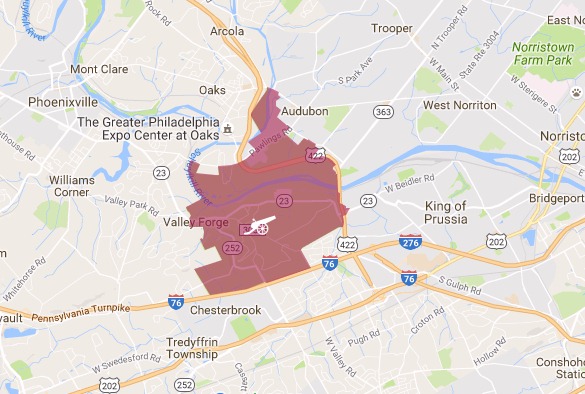

It was after the Battle of Germantown on October 4, 1977 that the Continental Army moved toward the Whitemarsh area. By the beginning of November, Washington had setup his camp on Fort Hill. On December 6, 1777, General Howe marched his British troops out of Philadelphia to attack Washington. However, Washington's position proved too strong. Though a contingent of Redcoats made it as far as Church Hill, they were unable to overtake Washington's Fort Hill.
Washington had managed to turn the British back with very little bloodshed. This American victory has become known as The Redoubt on Fort Hill.
As the winter weather turned more severe, Washington started moving his troops to Chester County. He hoped Valley Forge would offer the army a better place to build log cabins and supply the troops. On December 11, 1777, Washington pulled out of the Whitemarsh area. By December 18th, they had arrived in Valley Forge.
On December 19, 1777, when Washington's army marched into camp at Valley Forge, tired, cold, and ill-equipped, it was lacking in much of the training essential for consistent success on the battlefield. On June 19, 1778, after a six-month encampment, this same army emerged to pursue and successfully engage Lt. Gen. Sir Henry Clinton's British army at the Battle of Monmouth in New Jersey. The ordered ranks, martial appearance, revived spirit, and fighting skill of the American soldiers spoke of a great transformation having occurred amidst the cold, sickness, and hardship that was Valley Forge.
The army was undernourished and poorly clothed, living in crowded, damp quarters, and ravaged by sickness and disease. Typhoid, typhus, smallpox, dysentery, and pneumonia were among the numerous diseases that thrived in the camp during that winter. These diseases contributed to the death of 2,500 soldiers by the end of the winter, along with malnutrition and exposure to the freezing temperatures and snow.
Increasing military efficiency, morale, and discipline were as vital to the army's well-being as its supply of food and arms. The army had been handicapped in battle because unit training was administered from a variety of field manuals, making coordinated battle movements awkward and difficult. The soldiers were trained, but not uniformly. The task of developing and carrying out an effective training program fell to Baron Friedrich von Steuben, a skilled Prussian drill master who had recently arrived from Europe. He tirelessly drilled the soldiers, improving their battle and formation techniques greatly.
More About The Revolutionary War
On December 19, 1777, the Continental Army marched in to Valley Forge. For the next six months, the divided groups of militiamen would band together to form a true army, one capable of taking the fight to the British. Learn more about what happened here more than 200 years ago that makes this such an important place.
Valley Forge Historical Park is located just 18 miles west of Philadelphia along the Pennsylvania Turnpike (I-76). Neighboring communities include King of Prussia, home to the King of Prussia Mall, the largest shopping mall on the east coast; Oaks, home to the Greater Philadelphia Expo Center; and Phoenixville, a vibrant small town in neighboring Chester County.
